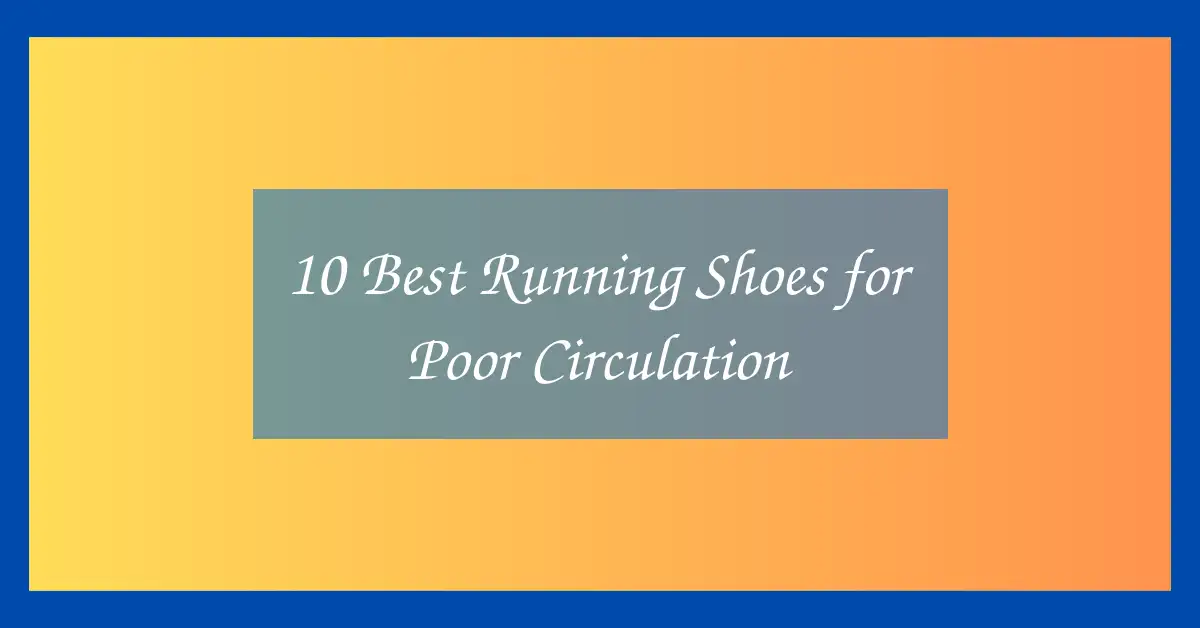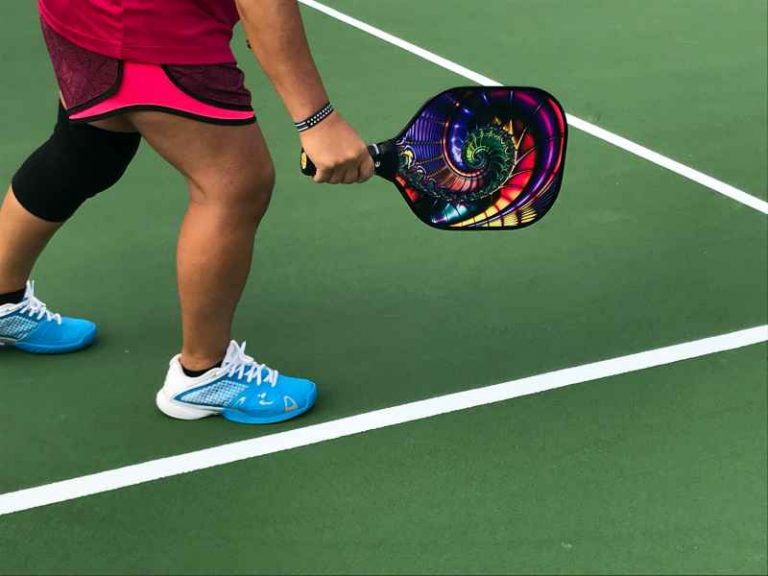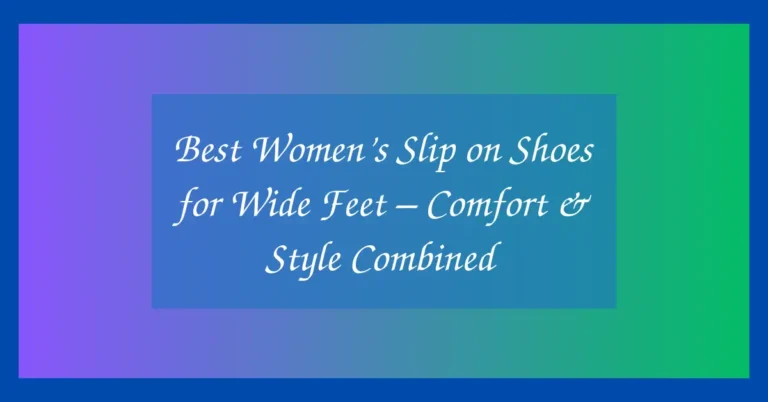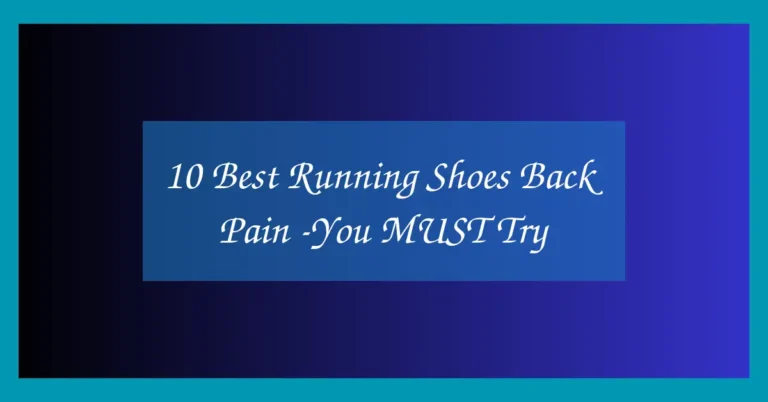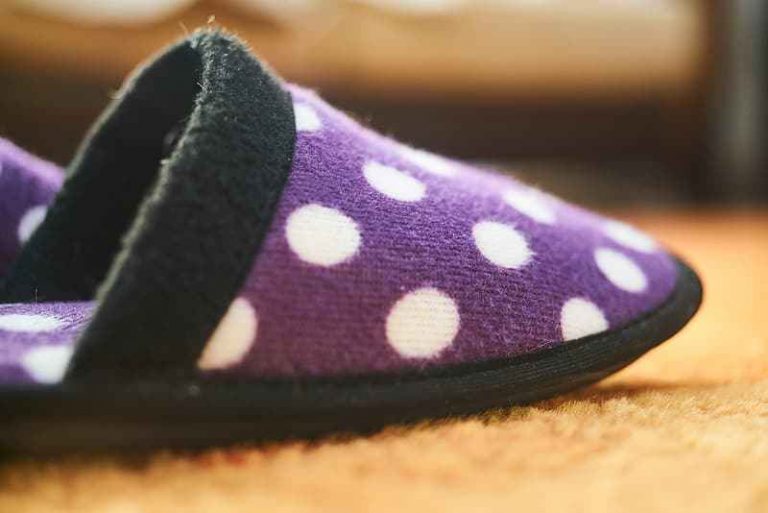10 Best Running Shoes for Poor Circulation
People suffering from poor circulation often face discomfort or numbness while walking or running. Finding the right pair of running shoes can make a noticeable difference. In this guide, we’ll explore the best running shoes for poor circulation that offer comfort, support, and promote healthy blood flow.
These shoes are not just about cushioning; they are built to enhance foot stability, relieve pressure points, and encourage better movement. Whether you’re an avid jogger or just trying to stay active, the following selections are tailored for comfort and performance. Let’s dive into the top picks that can help improve your daily stride.
Best Running Shoes for Poor Circulation
1. Brooks Ghost 15
The Brooks Ghost 15 is a cushioned neutral running shoe designed for smooth transitions and long-distance comfort. It comes with DNA Loft V2 cushioning which is softer and lighter than its predecessor. The engineered mesh upper keeps the foot cool and promotes better airflow during runs.
For runners with poor circulation, this shoe provides an adaptive fit that gently supports the arch without restricting blood flow. The soft interior and padded collar ensure reduced irritation or tight pressure around the ankle area. This is essential for individuals dealing with numbness or cold feet.
Its Segmented Crash Pad aids in shock absorption, helping distribute pressure evenly throughout the foot. This reduces localized strain which can worsen circulation issues. The outsole design also ensures smoother heel-to-toe transitions, reducing joint impact.
The Brooks Ghost 15 combines cushioning and structure to deliver a balanced, reliable running experience for those looking for comfort and support while managing circulation problems.
Pros
- Soft DNA Loft V2 cushioning
- Breathable engineered mesh upper
- Great shock absorption for smooth transitions
Cons
- Not ideal for overpronators
- Break-in period may be required
2. ASICS Gel-Nimbus 25
The ASICS Gel-Nimbus 25 offers plush cushioning and excellent underfoot support, making it a great option for those with poor circulation. Its PureGEL technology in the rearfoot absorbs impact and lessens vibration on landing. The FF BLAST PLUS ECO midsole offers a lighter, softer feel.
This shoe features an updated knit upper that wraps the foot in breathable comfort. It reduces hotspots and promotes even pressure distribution. This is helpful in maintaining warmth and consistent circulation during longer runs or walks.
It also includes a wide base and ample toe box that avoids unnecessary pressure on the toes. The relaxed fit is ideal for runners who want circulation-friendly shoes without compromising performance.
For anyone needing maximum cushioning and smooth ride with foot support, the Gel-Nimbus 25 delivers both comfort and stability, even on uneven surfaces.
Pros
- Exceptional heel cushioning with PureGEL
- Breathable knit upper construction
- Spacious toe box
Cons
- Heavier than minimal shoes
- Price may be high for casual runners
3. New Balance Fresh Foam 1080v13
The New Balance Fresh Foam 1080v13 blends ultra-plush cushioning with a pressure-free fit, making it ideal for poor circulation. Its Fresh Foam X midsole offers maximum softness without losing responsiveness, ideal for people who need all-day foot comfort.
The Hypoknit upper adapts to the foot’s shape, providing a gentle wrap that avoids tight pressure zones. This helps reduce numbness or tingling during extended wear. The midsole design also promotes smoother transitions and reduces impact shock.
For circulation benefits, the well-ventilated design allows better air flow while preventing overheating. The padded heel and collar add to the overall comfort while still offering structure and support.
It’s a top choice for runners or walkers needing extra support with reduced compression on sensitive areas, while still delivering performance-level features.
Pros
- Plush Fresh Foam X cushioning
- Flexible Hypoknit upper for gentle support
- Excellent airflow for breathability
Cons
- Wide fit might feel loose for narrow feet
- Slightly bulky for speed-focused runners
4. HOKA Clifton 9
The HOKA Clifton 9 is known for its soft cushioning and lightweight feel. It features compression-molded EVA foam that absorbs shock and lessens joint stress. Its rocker-shaped sole promotes a natural gait and helps minimize fatigue in the legs.
This model provides a roomy fit and a breathable upper that helps maintain consistent airflow. For poor circulation, the low-compression material and gentle arch support ensure there’s no excess pressure on veins or nerve areas.
The early-stage meta-rocker helps with smoother heel-to-toe transitions, reducing pressure buildup in the forefoot. The extended heel crash pad further improves the ride, absorbing impact and protecting sensitive areas.
Clifton 9 is ideal for those who want cushion-focused comfort and a design that keeps foot fatigue and circulation issues at bay, even during long runs or daily walking.
Pros
- Ultra-soft EVA foam midsole
- Roomy and breathable upper
- Rocker shape for efficient transitions
Cons
- May lack responsiveness for speed
- Minimal stability features
5. Saucony Triumph 21
The Saucony Triumph 21 is built for plush comfort and long-distance support. It uses PWRRUN+ foam for a responsive yet soft ride. This helps in absorbing shock and reducing muscle stress, which is beneficial for people with circulation problems.
The flat-knit upper improves breathability while gently hugging the foot, minimizing constriction. The midfoot saddle system provides a stable hold without creating hot spots. Together, these features promote continuous airflow and comfort during prolonged activity.
With a broad base and smooth heel-to-toe transition, the Triumph 21 works well for runners needing extra support and pressure relief. The padded tongue and collar also reduce the risk of irritation around the ankle and heel.
If you need premium cushioning with a circulation-friendly build, the Triumph 21 offers a soft, stable, and secure fit for your daily miles.
Pros
- Comfortable PWRRUN+ midsole
- Flat-knit upper reduces pressure points
- Stable ride with excellent padding
Cons
- May feel bulky to minimal shoe users
- Limited arch customization
6. Nike ZoomX Invincible Run Flyknit 3
The Nike ZoomX Invincible Run Flyknit 3 is designed for maximum cushioning and energy return. Its ZoomX foam is soft and bouncy, helping reduce pressure on the foot. This is essential for runners dealing with poor blood flow or nerve sensitivity.
The updated Flyknit upper is supportive and breathable, maintaining airflow without being overly tight. This allows proper circulation and keeps feet cooler during extended sessions. The wider forefoot design also improves balance and foot splay.
With a curved sole and reinforced heel clip, this shoe supports natural motion and stability. These features help reduce strain on the lower limbs and promote better alignment reducing circulation-related discomfort.
It’s ideal for recovery runs, casual joggers, or anyone who values cushion-rich comfort with soft landings that reduce foot stress and pressure.
Pros
- Highly cushioned ZoomX midsole
- Breathable and supportive Flyknit upper
- Wide forefoot for balance and comfort
Cons
- Stability may feel loose to some
- Not ideal for speed training
7. On Cloudstratus 3
The On Cloudstratus 3 features dual-layer CloudTec cushioning that absorbs impact while keeping the ride responsive. It is especially suitable for runners with circulation issues due to its flexible construction and breathable mesh upper.
The Speedboard design encourages forward propulsion without putting too much strain on the midfoot. This helps reduce fatigue and maintains foot comfort throughout longer runs. The plush tongue and heel collar prevent pressure around sensitive nerve zones.
With wide toe space and soft padding throughout, the shoe allows blood flow without tight grip. The supportive midsole adds comfort for flat feet or those needing gentle arch alignment without stiffness.
Runners needing a unique blend of cushioning, forward motion, and lightweight feel will benefit from the Cloudstratus’ thoughtful design for comfort and stability.
Pros
- Dual-layer CloudTec cushioning
- Spacious toe box and breathable mesh
- Flexible Speedboard for smooth stride
Cons
- Firm feel may not suit all runners
- Break-in period needed
8. Altra Torin 7
The Altra Torin 7 is crafted with a zero-drop platform and Balanced Cushioning, allowing natural foot positioning and even weight distribution. It’s especially great for runners with poor circulation needing pressure relief and neutral alignment.
The EGO MAX midsole offers soft yet responsive cushioning while reducing the impact on heel and forefoot. The FootShape toe box gives toes room to splay, helping improve foot flexibility and blood flow.
The engineered mesh upper keeps the foot ventilated and reduces tight contact areas, improving overall comfort. This layout supports healthy circulation and reduces the chance of tingling or numbness.
Torin 7 is ideal for runners who prefer natural foot positioning, zero-drop support, and a pressure-free fit that complements circulation needs.
Pros
- Zero-drop for natural foot movement
- Spacious FootShape toe box
- Cushioned and responsive EGO MAX midsole
Cons
- Zero-drop may need adjustment time
- Minimal arch support
9. Adidas Ultraboost Light
The Adidas Ultraboost Light is a lightweight version of the classic Ultraboost, with enhanced foam that cushions and supports every step. Its plush design makes it a good choice for runners who experience cold or numb feet due to poor circulation.
The Primeknit upper wraps the foot without being tight, offering a balance of support and stretch. This flexibility allows your foot to move naturally, helping promote healthy blood flow during each stride.
The Light BOOST foam ensures responsive and cushioned landings, especially useful for runners who experience foot fatigue. The flexible outsole design also promotes smooth movement and better impact absorption.
This model combines street-ready style with functionality, offering comfort, support, and breathability to help alleviate circulation issues during active use.
Pros
- Lightweight and plush Light BOOST foam
- Adaptive Primeknit upper
- Excellent energy return and impact protection
Cons
- May run narrow for wide feet
- Limited arch control
10. Mizuno Wave Rider 27
The Mizuno Wave Rider 27 offers a stable and well-cushioned ride with its ENERZY foam and wave plate design. It reduces joint shock and promotes better heel-to-toe transitions important for minimizing strain in runners with poor circulation.
The engineered mesh upper provides targeted breathability and support while allowing natural expansion of the foot. This helps improve comfort without cutting off circulation or creating pressure points.
The foam midsole cushions the stride without feeling overly soft, striking a balance between protection and responsiveness. The padded collar and tongue contribute to an irritation-free fit, especially around the ankle.
Runners looking for an all-round shoe that offers smooth transitions and breathable comfort will find the Wave Rider 27 to be an ideal match for daily training or casual use.
Pros
- Balanced cushioning with ENERZY foam
- Breathable and supportive mesh upper
- Wave plate for smooth transitions
Cons
- Midsole may feel firm to some
- Not suited for trail running
| Product Name | Cushioning Type | Upper Material | Best For | Fit Profile |
|---|---|---|---|---|
| Brooks Ghost 15 | DNA Loft V2 | Engineered Mesh | Daily Running | Neutral, Medium Fit |
| ASICS Gel-Nimbus 25 | PureGEL + FF Blast Plus | Knit Upper | Max Cushion Comfort | Relaxed, Breathable Fit |
| New Balance 1080v13 | Fresh Foam X | Hypoknit Mesh | Long Runs, Plush Feel | Roomy Toe, Soft Hold |
| HOKA Clifton 9 | Compression EVA | Engineered Mesh | Recovery & Daily Miles | Wide Fit, Lightweight |
| Saucony Triumph 21 | PWRRUN+ | Flat-Knit Mesh | Soft & Stable Runs | Secure, Cushioned Fit |
| Nike Invincible 3 | ZoomX Foam | Flyknit | Max Softness & Bounce | Wide Forefoot, Soft Grip |
| On Cloudstratus 3 | Dual CloudTec | Engineered Mesh | Flexible & Balanced Runs | Wide Toe, Structured Mid |
| Altra Torin 7 | EGO MAX | Engineered Mesh | Natural Foot Motion | Zero-Drop, Wide Toe |
| Adidas Ultraboost Light | Light BOOST | Primeknit | Stylish Daily Wear | Adaptive, Snug Wrap |
| Mizuno Wave Rider 27 | ENERZY + Wave Plate | Engineered Mesh | Balanced Training | Structured, Medium Fit |
Best Running Shoes for Poor Circulation Buying Guide
Importance of Cushioning for Circulation
When circulation is poor, the feet may experience discomfort, coldness, or numbness. Cushioning helps reduce pressure on sensitive areas and distributes impact evenly across the foot. Look for midsoles that provide soft, responsive, and consistent support during each step. Shoes with memory foam, EVA, or proprietary soft foam tech are especially helpful in reducing foot stress and improving blood flow during activity.
Breathability and Ventilation
Proper airflow is essential for regulating foot temperature and preventing moisture build-up, which can worsen circulation. Shoes with engineered mesh, knit uppers, or moisture-wicking linings help keep the feet dry and warm. This also reduces the risk of blisters or irritation in areas with reduced blood flow. Breathable shoes allow fresh air to circulate and keep the feet feeling fresh and active.
Fit and Pressure-Free Support
A snug but not tight fit is ideal for those with poor circulation. Too much compression can restrict blood flow, while loose shoes can cause friction. Shoes that offer a wide toe box, gentle arch support, and padded collars tend to work best. Choose a fit that hugs the foot comfortably without squeezing it, especially around the forefoot and ankle areas.
Lightweight Design and Smooth Transitions
Heavy shoes can cause unnecessary fatigue and disrupt blood flow in the lower limbs. Lightweight running shoes with rocker designs or smooth heel-to-toe transitions reduce muscular effort and keep circulation flowing evenly. A flexible sole that moves naturally with your stride can enhance comfort and reduce the chance of numbness or stiffness after long periods of wear.
Shock Absorption and Joint Protection
Good shock absorption prevents impact from being concentrated on specific pressure points, which is particularly important for people with vascular or nerve-related concerns. Choose shoes with built-in heel crash pads, gel inserts, or wave plates that absorb and redistribute force. This lowers the risk of joint pain, foot fatigue, and long-term discomfort.
FAQ
What causes poor circulation in the feet while running?
Poor circulation in the feet can be caused by various factors such as peripheral artery disease, diabetes, nerve compression, or tight footwear. During running, the demand for oxygen and blood flow increases. If blood vessels are constricted or shoes are too tight, it can lead to numbness, tingling, or coldness in the feet. Choosing the right shoes can help reduce symptoms and improve comfort.
How do running shoes help improve circulation?
Running shoes with soft cushioning, breathable materials, and ergonomic design help reduce pressure on nerves and blood vessels. A proper fit supports natural foot movement, while wide toe boxes allow blood to flow freely. Breathable uppers also help regulate temperature, which contributes to better circulation. These features work together to keep your feet comfortable and responsive throughout your run.
Are tight shoes bad for circulation?
Yes, tight shoes can restrict blood flow, especially around the toes and midfoot. This can worsen symptoms like numbness, cold feet, or tingling during or after running. It is important to wear shoes that offer a snug but relaxed fit without compressing any part of the foot. Wide sizing options and soft, stretchable materials are ideal for those concerned with circulation.
What features should I look for in shoes if I have cold feet?
Look for running shoes with thermal insoles, breathable uppers, and good cushioning. While warmth is important, ventilation helps regulate moisture and prevents further cooling. Foam-based cushioning can retain some heat and improve comfort. A proper fit is also crucial avoid shoes that are too tight, as they can make your feet colder by limiting blood flow.
Can orthopedic insoles help with circulation during running?
Orthopedic insoles can help improve foot alignment and relieve pressure from problem areas, which in turn may enhance circulation. They can also provide additional arch support and cushioning, making long runs more comfortable. However, they should be used with shoes that offer enough internal space, as crowded shoes may negate the benefits of the insole.
Are zero-drop shoes safe for runners with poor circulation?
Zero-drop shoes can be safe if they offer sufficient cushioning, arch support, and a wide toe box. These shoes promote natural foot alignment and encourage even weight distribution, which can help circulation. However, transitioning to zero-drop footwear should be done gradually, especially if you’re not used to the style, to avoid strain on your calves and feet.
Verdict
Choosing the best running shoes for poor circulation is about more than just comfort it’s about promoting better foot health with every step. The right pair will offer breathable support, gentle cushioning, and a secure yet flexible fit to improve blood flow and reduce discomfort. Whether you prefer plush stability or natural foot alignment, each shoe in this guide is designed to help you move confidently and comfortably day after day.

